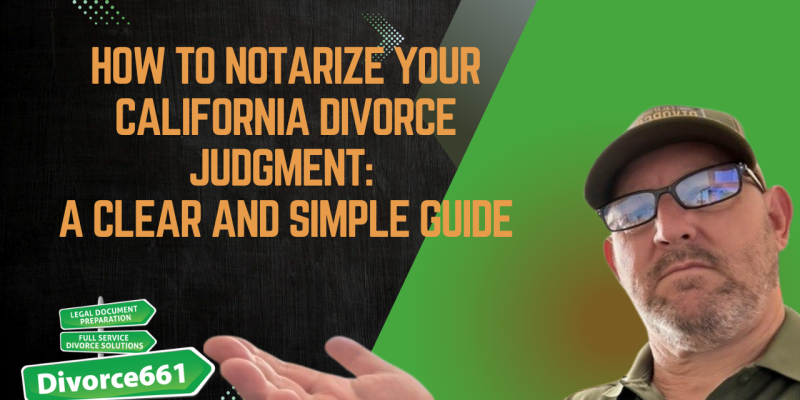How To Notarize Your California Divorce Judgment: A Clear and Simple Guide
When navigating the complexities of divorce proceedings, one of the final and crucial steps is ensuring that your divorce judgment and related documents are properly notarized. Many people get confused about what exactly is needed during this process, particularly regarding the role of the notary and the paperwork involved. This guide aims to clarify the essentials of notarizing your California divorce judgment, based on expert advice from Tim Blankenship of Divorce661.com.
Tim Blankenship, a trusted voice in divorce law, breaks down the notarization process into straightforward steps, emphasizing that the process is simpler than most expect. If you are in the final stages of your divorce and preparing to notarize your judgment, this article will help you understand exactly what to do — and what not to worry about.
Understanding the Role of a Notary in Divorce Judgments
One of the most common misconceptions people have about notarization is that the notary is responsible for verifying the contents of the document they are notarizing. This is not the case. The primary role of a notary public in the context of your divorce judgment is to serve as an impartial witness who confirms that the signatures on the document are authentic.
Tim Blankenship explains it clearly: when you go to a notary to get your divorce judgment notarized, the notary does not review the judgment itself or your settlement agreement. They are not there to validate or approve the terms of your divorce or ensure that the paperwork is completed correctly. Instead, their job is limited to acknowledging that the signature on the document is genuinely yours.
This distinction is crucial because it means that the notary will not—and should not—offer legal advice or check the substance of your divorce documents. Their function is purely administrative and procedural, focusing on the authenticity of the signature.
What Documents Do You Need to Bring to the Notary?
When it comes to notarizing your divorce judgment in California, many people wonder what exact paperwork they need to bring. Tim highlights that you do not need a “girat” or any other extra document beyond what is necessary for the acknowledgment form.
The key document that the notary needs to see and have signed is the judgment signature page. This page is specifically designed for notarization and is the only part of your divorce judgment paperwork that the notary will handle directly.
Along with this signature page, the notary will attach a notary acknowledgment form. This form serves as the official record that your signature on the judgment signature page was witnessed and verified by the notary.
It is important to note that the notary acknowledgment form is a standardized document that confirms the identity of the signer and the fact that the signing was done willingly and in the notary’s presence. It does not attest to the accuracy or legality of the contents of the judgment itself.
Why Only the Judgment Signature Page?
The judgment signature page is the focal point for notarization because it contains the actual signature that needs to be authenticated. The rest of your divorce judgment documents—including the settlement agreement, parenting plans, or support orders—do not require notarization unless specifically stated otherwise.
By limiting the notary’s review to the signature page, the process becomes faster and more efficient. It also reduces confusion about what the notary should or should not be doing.
Step-by-Step Process: How to Notarize Your California Divorce Judgment
To make things easier, here’s a simple step-by-step guide based on Tim Blankenship’s advice for how to get your divorce judgment notarized in California:
- Prepare Your Judgment Signature Page: Ensure that your judgment signature page is complete and ready to be signed. This page is typically provided by your attorney or the court clerk.
- Bring Valid Identification: When you visit the notary, bring a valid government-issued photo ID such as a driver’s license or passport. The notary must verify your identity to notarize your signature.
- Do Not Bring the Entire Judgment or Settlement Agreement: The notary does not need to see your entire divorce judgment or any supporting documents, only the signature page.
- Sign the Judgment Signature Page in the Notary’s Presence: You must sign the document in front of the notary. The notary cannot notarize a signature that was signed beforehand.
- The Notary Will Attach the Acknowledgment Form: After witnessing your signature, the notary will complete and attach the acknowledgment form to your judgment signature page.
- File the Notarized Judgment with the Court: Once notarized, file your judgment with the appropriate court to finalize your divorce proceedings.
Common Questions and Misconceptions About Notarizing Divorce Judgments
Do I Need a “Girat” or Any Other Special Form?
No. Contrary to some beliefs, you do not need a “girat” or any similar form when notarizing your divorce judgment. The only form necessary is the acknowledgment form that the notary will provide and attach to your judgment signature page. This simplifies the process and eliminates unnecessary paperwork.
Is the Notary Responsible for Checking My Divorce Documents?
No. The notary’s role is not to review, verify, or approve the contents of your divorce judgment or settlement agreement. Their role is strictly to confirm your identity and witness your signature. This is a key point to understand to avoid confusion or misplaced expectations during notarization.
What If I Don’t Have a Notary Near Me?
If you don’t have easy access to a notary public, there are several options available:
- Many banks and credit unions offer free notary services to their customers.
- Some shipping stores and postal service centers provide notary services for a small fee.
- Mobile notaries can come to your location for convenience, though this may involve additional costs.
Make sure to schedule an appointment and bring your valid ID and the judgment signature page ready to sign.
Why Proper Notarization Matters in Divorce Proceedings
Properly notarizing your divorce judgment is a critical step in ensuring that your divorce is legally finalized and enforceable. The notarization confirms the authenticity of your signature, which is essential for the court to accept the judgment as valid.
Failing to notarize the signature page correctly can lead to delays in the finalization of your divorce or even challenges to the enforceability of the judgment. Therefore, following these clear steps and understanding the role of the notary can save you time, money, and unnecessary stress.
Final Thoughts
Getting your California divorce judgment notarized doesn’t have to be complicated. By focusing on the judgment signature page and understanding that the notary’s role is limited to acknowledging your signature, you can navigate this step with confidence.
Remember, you don’t need any special forms beyond the acknowledgment, and the notary will not review or verify the contents of your divorce documents. If you follow these guidelines, you’ll be well on your way to finalizing your divorce smoothly.
If you want more detailed guidance on divorce procedures in California, resources like Divorce661.com provide valuable information and support from experts like Tim Blankenship.
Wishing you a smooth and stress-free divorce process!


